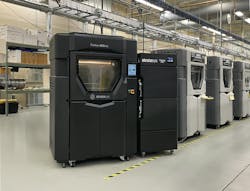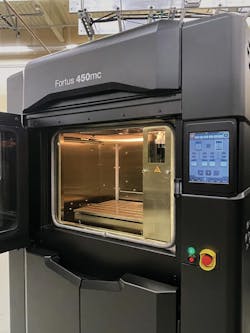“Mindful Manufacturing” Is Stratasys’ Vision for Sustainable, Scalable 3D Production
What You’ll Learn
- How the Fortus 450mc’s design enables long-term durability and repeatability in demanding industrial environments like aerospace and automotive manufacturing
- The evolution of additive manufacturing from prototyping to full-scale production, driven by engineering-grade materials and software integration
- Key lessons Stratasys learned from users that influenced upgrades in hardware, software and material versatility for modern manufacturing needs
- How 3D printing supports sustainability goals through waste reduction, circular manufacturing principles and on-demand production strategies
Stratasys recently marked the 10-year anniversary of its Fortus 450mc industrial fused deposition modeling (FDM) 3D printer. According to the company, 92% of the systems installed a decade ago remain in active use.
The 3D printer was engineered with durability and repeatability as primary objectives, according to Rich Garrity, chief business unit officer at Stratasys. “To put it simply, the 450 was designed and built with longevity in mind,” he told Machine Design. “Its ability to process high-performance thermoplastics like Ultem and Nylon 12CF, combined with a proven track record of uptime and reliability, makes it a true workhorse on the shop floor.”
He also said the system's modular design was engineered with an open architecture for easy upgrades so customers can scale as their needs evolve without replacing the system.
READ MORE: Market Intelligence on the Divergent Paths of 3D Printer Segments
What lessons has the company learned from users that have influenced the direction or focus of 3DP technology iterations? “Our customers have taught us that versatility and repeatability are non-negotiable. From aerospace to automotive, they need systems that deliver consistent parts with production-grade properties. That’s why we've focused on expanding our material portfolio, enhancing software automation and developing platforms that incorporate our customers’ real-world feedback,” Garrity said.
This printer is used in sectors such as aerospace, automotive and other industrial fields where high-strength jigs, fixtures, tooling and end-use parts are required. The Fortus 450mc supports industrial-grade composites such as carbon fiber-filled Nylon 12CF, which can provide performance comparable to some traditionally manufactured components.
Garrity says the printer shines in tough, high-demand environments. “We’ve seen customers use it to produce flight-ready ducting, rugged jigs and fixtures for automotive lines, and even battlefield-repair parts for military equipment.”
Recent Upgrades, Software Integration, Role of AM
To commemorate the 10-year milestone, Stratasys has introduced an upgraded version of the Fortus 450mc featuring:
- Hardened components to support abrasive and advanced materials such as FDM Nylon 12CF and Antero
- An all-materials license granting full access to the printers material portfolio
- One-year licenses for GrabCAD Streamline Pro and GrabCAD Print Pro, which provide enterprise level cybersecurity, real-time production monitoring and workflow optimization
- Automated fixture creation through the Fixture Mate tool by trinckle.
According to Garrity, “GrabCAD Streamline Pro software provides enterprise-grade cybersecurity capabilities to protect Stratasys printers and the network from cyberthreats and business disruptions.” The upgraded software aims to integrate the printer more effectively into Industry 4.0 manufacturing environments.
Further upgrades expected later this year include support for new glass-filled fire-resistant materials and faster build rates for specific filaments.
In the past 10 years, the role of 3D printing in engineering and manufacturing has shifted significantly, Garrity said. “Ten years ago, 3D printing was largely used for prototyping, and today it’s a critical tool for full scale production.” This change has been driven by delivering industrial grade reliability, expanded material performance and cost efficiency, according to Garrity.
In terms of design freedom, additive manufacturing removes many traditional constraints, allowing engineers to optimize parts for strength, weight and complexity without being limited by conventional tooling, he added.
Use cases for the printer range from flight-ready aerospace ducting and automative production fixtures to battlefield-repair part for military equipment. “While the broader industry is exploring 3D printing for prototyping and tooling, the 450mc proves that with the right materials and machine, you can take on real production challenges with confidence,” Garrity said.
Challenges and Misconceptions of Additive Manufacturing
The challenges facing mechanical and design engineers today include delivering complex parts on accelerated timelines with constrained budgets. Additive manufacturing supports meeting these demands by enabling rapid iteration and testing with engineering grade materials without waiting for tooling or outsourcing. “Engineers are under increasing pressure to do more with less on faster timelines, tighter budgets and with increased complexity,” Garrity noted. “Additive manufacturing helps break that bottleneck.”
READ MORE: Aerodynamic Design: Balancing Material Composition with Manufacturing Methods
A common misconception remains that 3D printing is only suitable for prototyping or parts with limited performance. Garrity addressed this, saying, “That may have been true over a decade ago, but it’s outdated thinking. Systems like the Fortus 450mc have been producing production-grade tools and components for years in some of the most demanding industries on the planet.”
When asked how mechanical designers can leverage advancements in 3D printing technologies to remain competitive in their fields, he answered: “Designers who embrace additive are no longer limited by traditional manufacturing rules. With additive, they’re free to optimize for strength, weight and function in ways that weren’t possible before. By integrating 3D printing into their workflows, designers are able to design smarter, more innovative products that give their companies a competitive edge.”
Sustainability and Future Trends
Additive manufacturing promotes waste reduction and material efficiency by constructing parts layer by layer and producing only what is needed. 3D printing represents a significant shift toward sustainable manufacturing through several key mechanisms, Garrity said, “including waste reduction and material efficiency, circular manufacturing principles such as through our ReLife solution—an overall carbon footprint reduction—and on-demand or as-needed production.
READ MORE: Pioneering Microscale 3D Printing in Cancer Therapy
“Overall, Stratasys has developed what we call ‘Mindful Manufacturing,’ a comprehensive sustainability strategy that calls for shared rethinking on the design and delivery of AM-enabled production,” he added, noting that this approach enables more sustainable production for manufacturing applications across supply chains, optimizing environmental impacts.
Regarding the future trends, Garrity expects the continued shift from prototyping to direct production, with growing volumes of qualified parts produced additively. “We're seeing companies move beyond one-off prototypes to producing medium and high volumes of qualified parts reliably and repeatedly for demanding applications, driven in part by advanced engineering-grade materials that expand application possibilities, particularly in industries with stringent requirements such as aerospace, automotive and medical,” he said.
He added that the future lies in holistic solutions that integrate hardware, software and materials. “Our GrabCAD software ecosystem streamlines the additive manufacturing process with features like print preparation, job management and traceability for printed parts,” he said, noting that the Fortus 450mc aligns perfectly with these trends by offering production-ready reliability for consistent, repeatable manufacturing; large build volume capability for bigger parts and batch production; and engineering-grade materials.
“It’s a workhorse for manufacturers who need reliable, high-quality parts in materials that meet demanding application requirements,” Garrity concluded.
About the Author
Sharon Spielman
Technical Editor, Machine Design
As Machine Design’s technical editor, Sharon Spielman produces content for the brand’s focus audience—design and multidisciplinary engineers. Her beat includes 3D printing/CAD; mechanical and motion systems, with an emphasis on pneumatics and linear motion; automation; robotics; and CNC machining.
Spielman has more than three decades of experience as a writer and editor for a range of B2B brands, including those that cover machine design; electrical design and manufacturing; interconnection technology; food and beverage manufacturing; process heating and cooling; finishing; and package converting.
Email: [email protected]
LinkedIn: @sharonspielman
Facebook: Machine Design
YouTube: @MachineDesign-EBM


